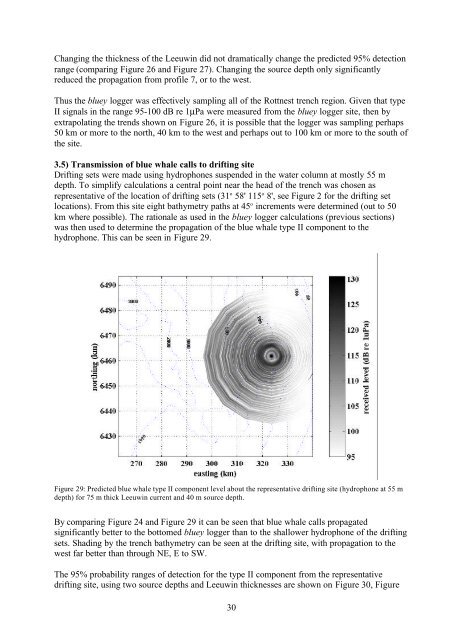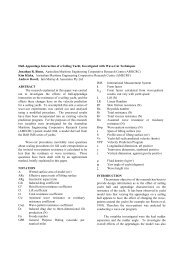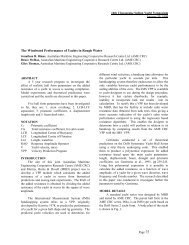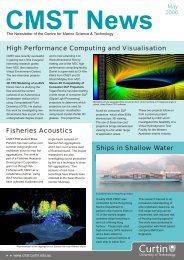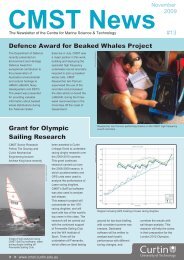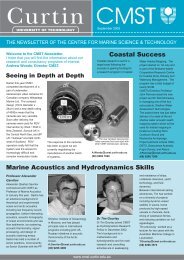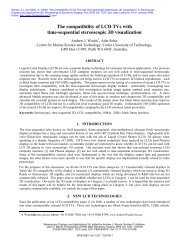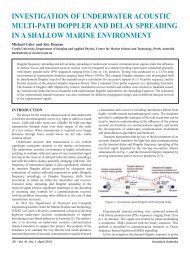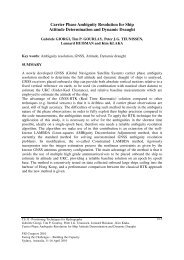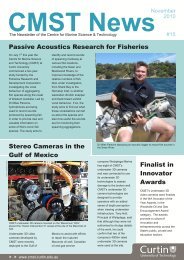Blue whale calling in the Rottnest trench-2000, Western ... - ANP
Blue whale calling in the Rottnest trench-2000, Western ... - ANP
Blue whale calling in the Rottnest trench-2000, Western ... - ANP
You also want an ePaper? Increase the reach of your titles
YUMPU automatically turns print PDFs into web optimized ePapers that Google loves.
Chang<strong>in</strong>g <strong>the</strong> thickness of <strong>the</strong> Leeuw<strong>in</strong> did not dramatically change <strong>the</strong> predicted 95% detection<br />
range (compar<strong>in</strong>g Figure 26 and Figure 27). Chang<strong>in</strong>g <strong>the</strong> source depth only significantly<br />
reduced <strong>the</strong> propagation from profile 7, or to <strong>the</strong> west.<br />
Thus <strong>the</strong> bluey logger was effectively sampl<strong>in</strong>g all of <strong>the</strong> <strong>Rottnest</strong> <strong>trench</strong> region. Given that type<br />
II signals <strong>in</strong> <strong>the</strong> range 95-100 dB re 1μPa were measured from <strong>the</strong> bluey logger site, <strong>the</strong>n by<br />
extrapolat<strong>in</strong>g <strong>the</strong> trends shown on Figure 26, it is possible that <strong>the</strong> logger was sampl<strong>in</strong>g perhaps<br />
50 km or more to <strong>the</strong> north, 40 km to <strong>the</strong> west and perhaps out to 100 km or more to <strong>the</strong> south of<br />
<strong>the</strong> site.<br />
3.5) Transmission of blue <strong>whale</strong> calls to drift<strong>in</strong>g site<br />
Drift<strong>in</strong>g sets were made us<strong>in</strong>g hydrophones suspended <strong>in</strong> <strong>the</strong> water column at mostly 55 m<br />
depth. To simplify calculations a central po<strong>in</strong>t near <strong>the</strong> head of <strong>the</strong> <strong>trench</strong> was chosen as<br />
representative of <strong>the</strong> location of drift<strong>in</strong>g sets (31 o 58' 115 o 8', see Figure 2 for <strong>the</strong> drift<strong>in</strong>g set<br />
locations). From this site eight bathymetry paths at 45 o <strong>in</strong>crements were determ<strong>in</strong>ed (out to 50<br />
km where possible). The rationale as used <strong>in</strong> <strong>the</strong> bluey logger calculations (previous sections)<br />
was <strong>the</strong>n used to determ<strong>in</strong>e <strong>the</strong> propagation of <strong>the</strong> blue <strong>whale</strong> type II component to <strong>the</strong><br />
hydrophone. This can be seen <strong>in</strong> Figure 29.<br />
Figure 29: Predicted blue <strong>whale</strong> type II component level about <strong>the</strong> representative drift<strong>in</strong>g site (hydrophone at 55 m<br />
depth) for 75 m thick Leeuw<strong>in</strong> current and 40 m source depth.<br />
By compar<strong>in</strong>g Figure 24 and Figure 29 it can be seen that blue <strong>whale</strong> calls propagated<br />
significantly better to <strong>the</strong> bottomed bluey logger than to <strong>the</strong> shallower hydrophone of <strong>the</strong> drift<strong>in</strong>g<br />
sets. Shad<strong>in</strong>g by <strong>the</strong> <strong>trench</strong> bathymetry can be seen at <strong>the</strong> drift<strong>in</strong>g site, with propagation to <strong>the</strong><br />
west far better than through NE, E to SW.<br />
The 95% probability ranges of detection for <strong>the</strong> type II component from <strong>the</strong> representative<br />
drift<strong>in</strong>g site, us<strong>in</strong>g two source depths and Leeuw<strong>in</strong> thicknesses are shown on Figure 30, Figure<br />
30


